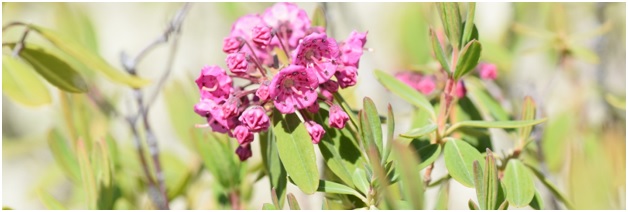
A Tamarack (Larix laricina) seedling transplanted at my field site, King’s Point, NL.
Well the growing season has definitely arrived in Newfoundland. I just came back from a hike where I noticed that for the most part, wildflowers have come and gone and that all the berries (which Newfoundland is known for) are starting to develop. In fact, I found a great bakeapple spot that I am going to return to next week in hopes of foraging enough berries to make a pie. So folks, lets go a month back in time to my last blog post where I was wondering when growing season was going to arrive, and while waiting for it, I was preparing for my June field work trip. Since then I have been out in the field twice and yup, growing season has arrived but what I was expecting I did not find….
My Masters research is focused on exploring non-climatic constraints on early life stages of Black Spruce and Tamarack at treeline. This research is focused around the hypothesis that with atmospheric warming, species will track the climatic niche they are adapted to and their ranges will shift up-slope and to greater elevations. Although the Earth has warmed, globally there has been a lack of response by tree species. Thus, I am asking what, other than the climate, is constraining tree range expansion, and because intuitively, range expansion is dependent on the successful germination of seeds and survival of young life stages, I am focused on these ontological stages. So last fall I experimentally manipulated several non-climatic constraints and sowed thousands of spruce and tamarack seeds around my plots at King’s Point, NL.
Okay, so now that the backstage has been set I am sure you can picture me patiently waiting for the growing season so I can survey my plots and count how many seeds (that I had so carefully counted, packaged, and sowed) successfully germinated. June came and we headed west, and only 1 seed had germinated….well that was underwhelming and much less than expected. But it was cold and wet during our June field trip and we had a few miserable days so maybe the right growing conditions just hadn’t been met yet. July came and again we packed up and headed west. The weather was gorgeous, we were working in tank tops, but yet again germination was so low; at most 10 seeds had germinated, which is much too low to actually do any statistics on. The slogan for our field season has been “zeros are still results”, which of course cannot be denied but zeros lead to some serious disappointment. After months of exploring literature, I had many predictions in my mind and pictured that my project would be centered on seed germination. But I soon realized that my master’s thesis was not going to be what I thought it was going to be. And to be honest, that, at first, is a scary idea to wrap your head around. The positive thing about zeros is that they lead to so many other questions. Why did so few seeds germinate? Was it this year’s weather? Was it seed predation? Were other plants inhibiting the seeds? Thankfully for me there is still plenty of time in this field season to design and implement secondary experiments in which will hopefully satisfy my curiosity over what is going on in this system. I am also thankful of the insight of my supervisor this past fall, who posed the question “what if your experiment doesn’t work out? What’s plan B?” We decided to add an additional lifestage to the project, where 6 month old seedlings that I grew in the laboratory (with the help of friends when I was out of town) were transplanted at my study site and their survival and growth is being monitored. Having these seedlings transplanted and that aspect of my experiment going smoothly definitely alleviated some of the worry I had over the lack of germination, and definitely kept me from feeling a more deep-seated fear that my project was going to be a failure.
I think John Pastor, Professor at the University of Minnesota Duluth and author of What Does a Clever Moose Eat?, very eloquently summarizes my experience this summer. So I’ll end this week’s blog post by quoting Dr. Pastor,
“things get interesting when our well-thought-out (and well-cherished) hypotheses or predictions are rejected. This is why we shouldn’t be afraid to reject our most cherished hypotheses: the way nature works is always far more interesting than what we originally thought. This is one of the more difficult and uncomfortable (but also more valuable) things we learned in graduate school” (p. 119).
Cheers,
~Anna

Kalmia angustifolia is known to inhibit Black Spruce establishment from seed- is the abundance of this species driving the lack of germination?
J. Pastor. 2016. What should a clever moose eat? Natural history, ecology, and the north woods. Island Press, Washington, DC.